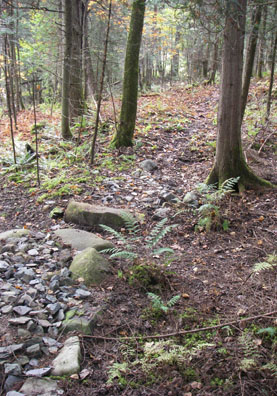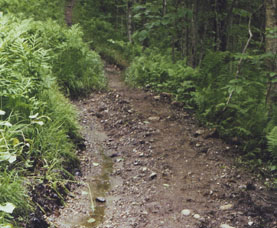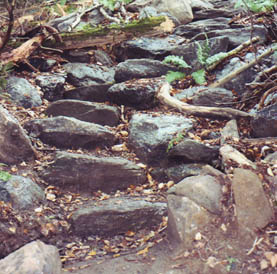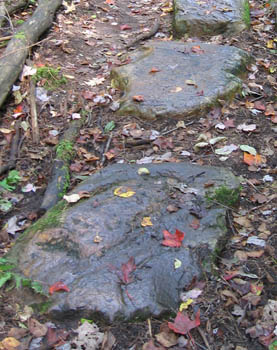Trail Structure Glossary
this is an adaptation of the Mallory Brook Trail Work Log Glossary, written by Greg Western
 |
CrossdrainUsed where . . . the trail is muddy because water is draining from uphill, across the trail. (As opposed to water that is draining along the trail; or water that is simply saturating the ground.) Built by . . . placing large stones on either side of the drainage. This makes a non-eroding channel for water to cross the trail, and provides hikers with solid footing to step across the drainage. Note . . . crossdrains are time consuming to build, because many stones must be used, they must be buried deeply to anchor them against the erosive power of the water, and the stones in the treadway must be artfully arranged so they are convenient to walk on.TurnpikingUsed where . . . the trail is muddy because the ground is saturated with water and can be only partially dried up or drained. Built by . . . crushing rock on the treadway to pave it with fist sized (or smaller) pieces of gravel. The trail is lined with larger stones to hold the gravel in place. Note . . . often paired with a ditch dug parallel to the trail, on the uphill side, which leads to a Crossdrain. |
 |
Ditch and FillUsed where . . . trail is a little muddy due to groundwater draining through and saturating the soil. Built by . . . digging a ditch uphill and parallel to (or sometimes on both sides of) trail. This ditch acts as a curtain drain, lowering the water table in its lee, and drying the treadway. Additional dirt, such as from the ditch, is piled in the tread to further elevate it above the water saturated level. Note . . .the ditch must drain somewhere, often to a Crossdrain. |
 |
SidehillUsed where . . . the trail crosses a steep side slope. Built by . . . digging a bench into the side of the hill, making treadway which is level from side to side, but which is ramped up in the direction the trail is climbing. Note . . . requires deep mineral soil to dig into. This is often not available where Vermont trails are located. |
 |
StairstepsUsed where . . . the trail climbs steep slopes. In these locations hiker traffic combined with occasional water flow (from rain, snow melt, etc.) erodes the trail - creating gullies, carrying sediment into any waterways at the base of the hill, and ultimately causing treacherous footing. Built by . . . burying large stones in the hillside to form staircases. Additional stones are set along the stairs to prevent them from being eroded out of place by water washing around them or by hikers walking around them. Note . . . this is labor intensive, skilled work. Stones are set resting on each other - interlocking, like in a stone wall. |
 |
StepstonesUsed where . . . the trail is muddy because the ground is saturated with water and cannot be drained at all. (Flat ground, for example, cannot easily be drained.) Built by . . . burying very large stones in the trail with a flat side up forming a reliable stepping surface. Like an iceberg, most of the stone is buried in the ground which anchors it solidly despite the wet, unstable ground. Note . . . the large stones required are difficult to move to the work site, and difficult to maneuver across muddy ground. Also, Stepstones are washed out by flowing water, and so can only be built where the trail crosses flat ground (where there is no flow along the trail from rain, etc.) and where there is no water draining across the trail. |